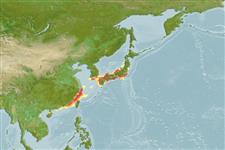Teleostei (teleosts) >
Gobiiformes (Gobies) >
Gobiidae (Gobies) > Gobiinae
Eponymy: Professor Cornelius Jan van der Horst (1889–1951) was a Dutch zoologist who moved to South Africa (1928) and became Head of the Zoology Department, Witwatersrand University, Johannesburg. [...] (Ref. 128868), visit book page.
Environment: milieu / climate zone / depth range / distribution range
Ecology
Marine; demersal; depth range 60 - 123 m (Ref. 75057). Subtropical
Northwest Pacific: China and Japan (Ref. 75057).
Size / Weight / Age
Maturity: Lm ? range ? - ? cm
Max length : 4.0 cm SL male/unsexed; (Ref. 75057)
Short description
Identification keys | Morphology | Morphometrics
Dorsal spines (total): 7; Dorsal soft rays (total): 11 - 12; Anal spines: 1; Anal soft rays: 11. This species is distinguished from its congeners by the following set of characters: 11-12 (usually 11) segmented rays on second dorsal fin; 26-27 (-30?) longitudinal scale count; predorsal scales absent; 8 transverse scales from origin of second dorsal fin backward and downward to anal-fin base; pectoral-fin base naked; anterior 3 spines of first dorsal fin usually elongate and filamentous, extending posteriorly to base of first, second or third segmented ray of second dorsal fin; connecting membrane between innermost rays well developed; when fresh: irregular shaped yellow (pale in preservative) markings on cheek and operculum, oblique narrow yellow line from posterior end of eye to nape, small bright yellowish red spot on center or anteroventral part of operculum, ca. 9 narrow yellow vertical bars on body, distal tip of first dorsal fin vivid red, and a narrow yellow longitudinal band on middle of anal fin (Ref. 75057).
Life cycle and mating behavior
Maturity | Reproduction | Spawning | Eggs | Fecundity | Larvae
Eschmeyer, W.N. (ed.), 2006. Catalog of fishes. Updated database version of April 2006. Catalog databases as made available to FishBase in April 2006. (Ref. 56787)
IUCN Red List Status (Ref. 130435: Version 2024-2)
Threat to humans
Harmless
Human uses
Tools
Special reports
Download XML
Internet sources
Estimates based on models
Phylogenetic diversity index (Ref.
82804): PD
50 = 0.5000 [Uniqueness, from 0.5 = low to 2.0 = high].
Bayesian length-weight: a=0.00955 (0.00355 - 0.02566), b=3.03 (2.80 - 3.26), in cm total length, based on LWR estimates for this (Sub)family-body shape (Ref.
93245).
Trophic level (Ref.
69278): 3.2 ±0.3 se; based on size and trophs of closest relatives
Resilience (Ref.
120179): High, minimum population doubling time less than 15 months (Preliminary K or Fecundity.).
Fishing Vulnerability (Ref.
59153): Low vulnerability (10 of 100).
